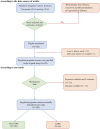ZJU index as a predictive biomarker of gestational diabetes mellitus: a prospective cohort analysis
- PMID: 40584102
- PMCID: PMC12202635
- DOI: 10.3389/fnut.2025.1570771
ZJU index as a predictive biomarker of gestational diabetes mellitus: a prospective cohort analysis
Abstract
Background: The ZJU index, incorporating fasting plasma glucose (FPG), lipid profiles, liver enzymes, and body mass index (BMI), serves as a multidimensional tool for assessing metabolic dysregulation. This prospective investigation examined first-trimester ZJU index associations with both gestational diabetes mellitus (GDM) risk and nonalcoholic fatty liver disease (NAFLD) during pregnancy, while simultaneously evaluating the relationships between lipid profiles, liver enzymes, and GDM development.
Methods: We conducted analyses using multivariable logistic regression and restricted cubic splines (RCS) to assess associations of the ZJU index, liver enzymes, and blood lipids with GDM, as well as the association between the ZJU index and NAFLD. Subgroup analyses were conducted to evaluate the correlation between the ZJU index (stratified by age and reproductive history) and GDM. The receiver operating characteristic (ROC) curve assessed the ZJU index's predictive power. The robustness of the findings was verified via sensitivity analyses.
Results: In the multivariable regression model, the ZJU index showed a significant positive association with GDM, after adjusting for confounders [OR = 1.22, 95% CI (1.13-1.32)]. The RCS analysis revealed a linear dose-response relationship between the ZJU index and GDM. The area under the curve (AUC) for the ZJU index was 0.802, indicating a high predictive ability for GDM. Associations between the ZJU index and GDM remained consistent across subgroups and sensitivity analyses.
Conclusion: The ZJU index is closely associated with GDM prevalence.
Keywords: ZJU; early pregnancy; gestational diabetes mellitus; lipid index; liver enzyme.
Copyright © 2025 Xu, Li, Wang, Xu and Li.
Conflict of interest statement
The authors declare that the research was conducted in the absence of any commercial or financial relationships that could be construed as a potential conflict of interest.
Figures



Similar articles
-
First trimester hepatic steatosis index as a predictor of gestational diabetes mellitus: a cohort study in Northwestern China.Sci Rep. 2025 Jul 1;15(1):20975. doi: 10.1038/s41598-025-04510-6. Sci Rep. 2025. PMID: 40595842 Free PMC article.
-
Relationship Between the ZJU Index and Infertility Risk in Reproductive-Aged US Women: An Analysis of NHANES 2013-2018.Int J Womens Health. 2025 Jul 14;17:2063-2073. doi: 10.2147/IJWH.S527967. eCollection 2025. Int J Womens Health. 2025. PMID: 40689414 Free PMC article.
-
Different intensities of glycaemic control for women with gestational diabetes mellitus.Cochrane Database Syst Rev. 2023 Oct 10;10(10):CD011624. doi: 10.1002/14651858.CD011624.pub3. Cochrane Database Syst Rev. 2023. PMID: 37815094 Free PMC article.
-
Nonlinear association of a composite metabolic index (ZJU index) with hypertension: a cross-sectional study of NHANES 2003-2018.Front Cardiovasc Med. 2025 Jun 18;12:1608648. doi: 10.3389/fcvm.2025.1608648. eCollection 2025. Front Cardiovasc Med. 2025. PMID: 40606025 Free PMC article.
-
Combined diet and exercise interventions for preventing gestational diabetes mellitus.Cochrane Database Syst Rev. 2017 Nov 13;11(11):CD010443. doi: 10.1002/14651858.CD010443.pub3. Cochrane Database Syst Rev. 2017. PMID: 29129039 Free PMC article.
References
-
- Wang H, Li N, Chivese T, Werfalli M, Sun H, Yuen L, et al. IDF diabetes atlas: estimation of global and regional gestational diabetes mellitus prevalence for 2021 by International Association of Diabetes in pregnancy study group’s criteria. Diabetes Res Clin Pract. (2022) 183:109050. doi: 10.1016/j.diabres.2021.109050 - DOI - PubMed
LinkOut - more resources
Full Text Sources

